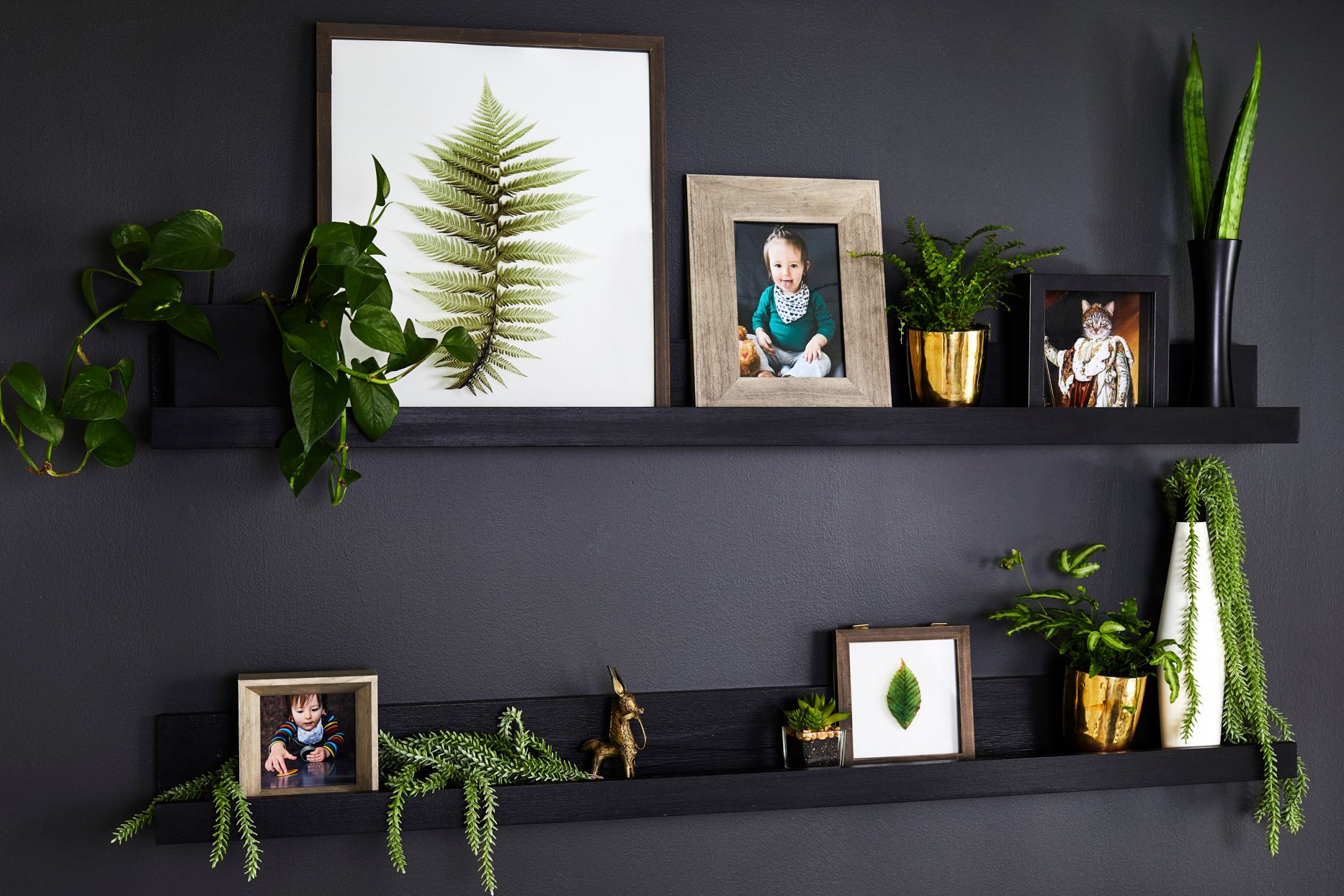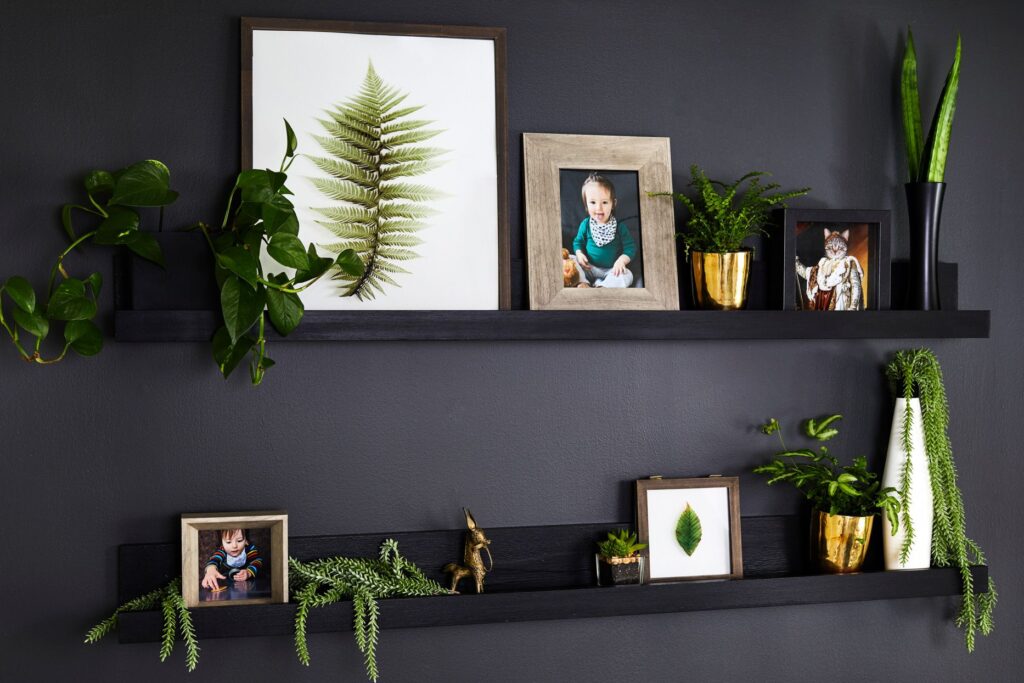You want a thriving, vibrant garden—one that yields abundant harvests, repels pests naturally, and fosters a sense of harmony among diverse plants.
If you’ve ever wondered how to achieve this without leaning heavily on chemical fertilizers or pesticides, companion planting is your answer.
Companion planting is all about pairing specific plants together so that they benefit each other. By placing compatible species side by side, you can optimize space, encourage pollination, suppress weeds, and even enhance flavor.
Imagine strolling through your garden, inhaling the aroma of basil flourishing beside tomatoes, or admiring marigolds nestled in between rows of peppers.
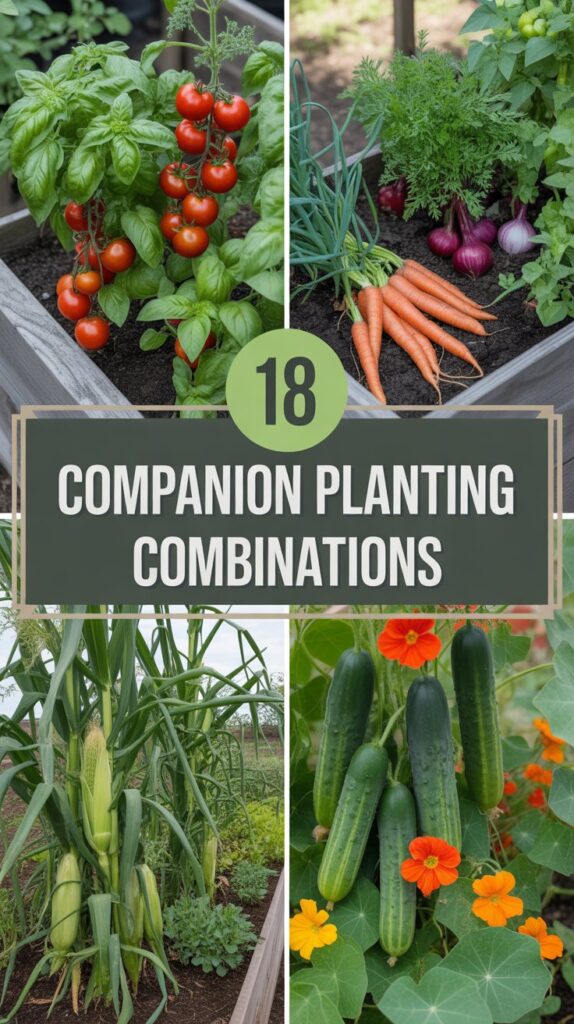
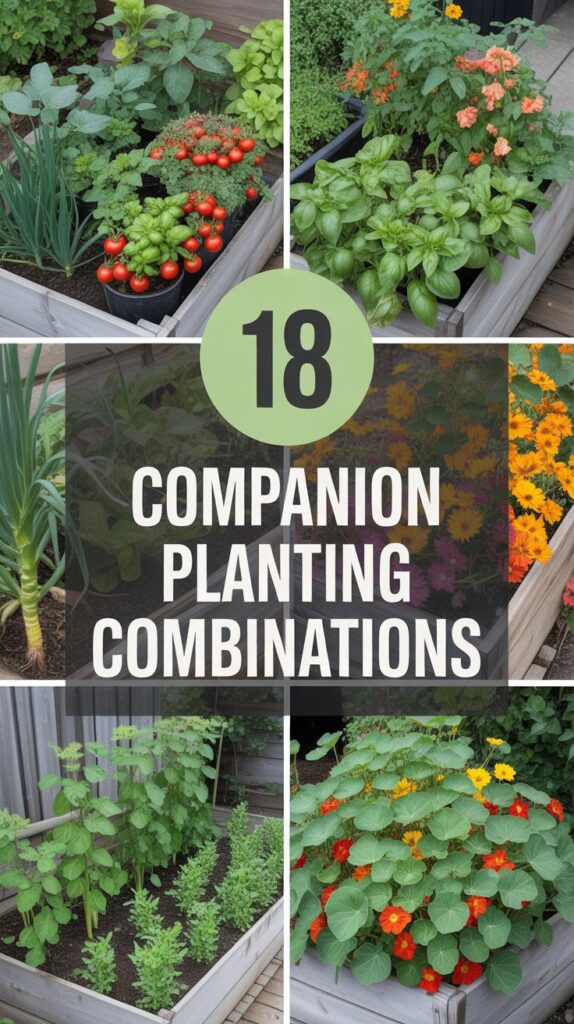
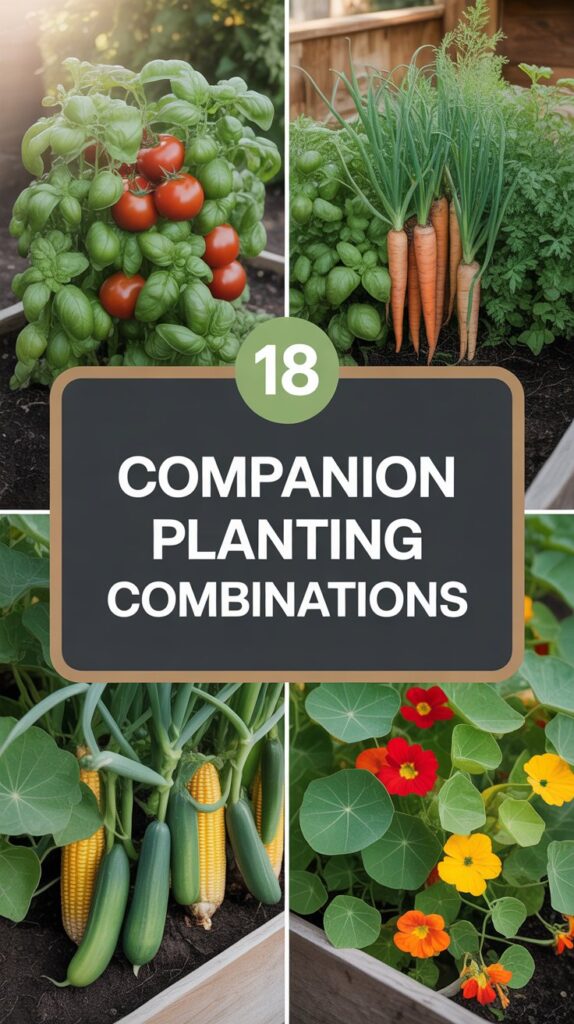
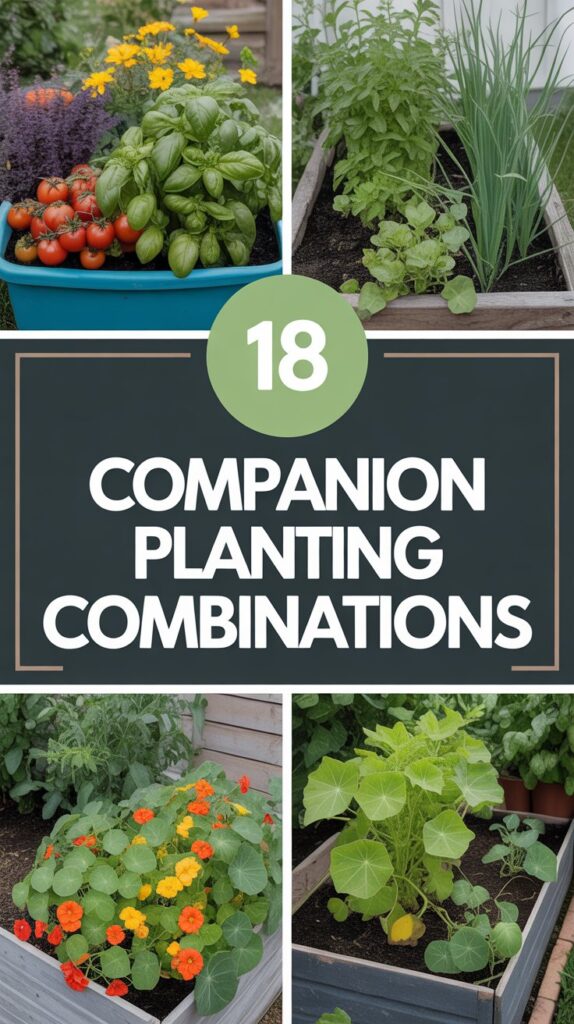
These plant partnerships not only add visual interest but also improve the health and yield of your crops. Every plant has unique traits—some attract beneficial insects, while others deter pests. Certain plants pull nutrients from deeper layers of the soil, making them accessible to neighboring crops.
Others excrete chemicals that repel or confuse common garden nuisances. When you harness these natural interactions, you reduce your reliance on artificial solutions and cultivate a more sustainable, eco-friendly environment.
In this article, you will discover 18 Companion Planting Combinations that have stood the test of time in countless gardens worldwide.
Each pairing or grouping showcases ways in which plants look out for one another—whether it’s through nutrient exchange, pest deterrence, or shared growing conditions.
By the time you finish reading, you’ll understand the core principles of companion planting and be ready to design a healthier, more productive space that benefits the environment, your dinner table, and your enjoyment of gardening.
Table of Contents
- 18 Companion Planting Combinations
- 1. Tomatoes and Basil
- 2. Carrots and Onions
- 3. Corn and Squash
- 4. Lettuce and Radishes
- 5. Peppers and Marigolds
- 6. Beans and Corn
- 7. Cucumbers and Nasturtiums
- 8. Potatoes and Horseradish
- 9. Spinach and Strawberries
- 10. Eggplant and Amaranth
- 11. Broccoli and Rosemary
- 12. Celery and Leeks
- 13. Roses and Garlic
- 14. Grapes and Hyssop
- 15. Zucchini (or Other Summer Squash) and Borage
- 16. Cabbage and Chamomile
- 17. Beans and Summer Savory
- 18. Peas and Mint
- Conclusion
- FAQs
18 Companion Planting Combinations
Below, you’ll find 18 tried-and-true plant partnerships. Each suggestion highlights why these combinations work and how they can help you create a flourishing garden ecosystem.
1. Tomatoes and Basil
Tomatoes and basil make a classic garden duo, celebrated as much for their culinary compatibility as for their mutual benefits in the garden. Basil’s strong aroma helps repel common tomato pests like aphids and whiteflies. In turn, tomatoes provide partial shade to the basil, especially during hotter parts of the day, keeping the herb’s leaves from scorching. The subtle humidity created by tomato foliage also helps basil thrive.
Beyond pest control, some gardeners claim basil enhances the flavor of tomatoes, making harvest time even more rewarding. Whether you believe in that flavor boost or not, there’s no denying the practical advantages these two share. If you want to maximize space, interplant basil around the base of tomato plants. Just be sure to give each plant enough room for air circulation, as tomatoes can be prone to fungal issues if they remain too damp. Proper spacing ensures that leaves dry quickly after watering or rain, helping both your tomatoes and basil remain disease-free.
2. Carrots and Onions
Carrots and onions are a complementary match when grown in the same bed. Onions emit a pungent odor that confuses and deters carrot flies, a common pest that lays eggs near carrot roots. Meanwhile, carrots help break up the soil around onions, allowing the bulbs to expand more easily.
One tip to consider: plant rows of onions alongside rows of carrots, leaving enough space for each crop to develop. Carrot seedlings can be a bit slow to germinate, so patience is key. The reward is a pest-reduced environment and potentially better yields. Keep the soil moderately moist and ensure proper thinning; overcrowded carrots can grow deformed roots, and onions also need breathing room to form sizable bulbs. Harvesting these two staples can be extra satisfying when you know they’ve looked out for each other from seed to table.
3. Corn and Squash
The pairing of corn and squash (think pumpkins, zucchini, or other gourds) traces its roots back to ancient agricultural practices. Often grown together in the “Three Sisters” method (along with beans), corn and squash have a symbiotic relationship that benefits both. Corn provides a natural trellis for climbing squash vines, offering support and saving space. Meanwhile, the large squash leaves shade the soil, helping retain moisture while suppressing weeds.
When combined with beans, this trio can create an even more robust ecosystem—beans fix nitrogen in the soil, benefiting heavy feeders like corn. However, even without beans, corn and squash work in tandem. Squash’s sprawling growth helps deter pests by creating a dense groundcover. If you have limited space, consider bush-type squash varieties around the base of your corn stalks. Water consistently—corn is thirsty—and keep an eye out for squash vine borers. With regular care, you’ll enjoy a high-yielding, efficient planting system.
4. Lettuce and Radishes
If you’re searching for fast-growing, cool-season veggies that can share a garden bed, lettuce and radishes are an excellent match. Radishes mature quickly, often within three to four weeks, while lettuce takes a bit longer. By the time radishes are ready to harvest, they free up space for lettuce to continue to expand.
Moreover, the broad lettuce leaves can shade the soil, keeping radishes cool and reducing the likelihood of the radishes becoming too spicy or woody. In turn, radishes loosen the soil around the lettuce roots. This dynamic can be a space-saver in smaller gardens, especially if you practice succession planting. Remove the radishes when they’re tender and crisp, then give the lettuce more room to grow. With minimal effort and clever spacing, you’ll enjoy fresh salads in no time.
5. Peppers and Marigolds
Marigolds are the unsung heroes of many companion planting schemes. Their roots secrete substances that deter nematodes, microscopic worms that can damage plants’ root systems. When grown near peppers—whether bell peppers, hot peppers, or ornamental varieties—marigolds offer an extra line of defense against soil-borne pests.
This partnership is also visually appealing. The bright, warm tones of marigold blooms contrast beautifully with lush green pepper foliage. Beyond nematode control, marigolds can repel aphids and whiteflies, helping your peppers stay healthy. To maximize effectiveness, don’t bury marigolds too close to pepper stems; give each plant enough space to flourish. With regular watering and some organic mulch, you’ll have a pepper patch that’s as colorful as it is productive.
6. Beans and Corn
Another iconic duo in the “Three Sisters” approach, beans and corn, share a cooperative relationship that improves soil fertility and plant stability. Climbing beans wind up corn stalks, using them as a natural support structure, eliminating the need for separate trellises. In return, the beans fix nitrogen in the soil, enhancing the corn’s growth in subsequent seasons.
When planting, place your bean seeds near the corn plants once the corn reaches about six inches in height. This timing ensures the corn is sturdy enough to handle bean vines. As the beans climb, monitor for pests like corn earworms or bean beetles, and address issues promptly with organic pest control methods. Keep the soil consistently moist, but avoid waterlogging. Over time, you’ll reap the benefits of a self-supporting system that also enriches the garden bed for future crops.
7. Cucumbers and Nasturtiums
Cucumbers thrive with companions that repel pests and invite beneficial insects, and nasturtiums do both exceptionally well. Nasturtiums act like a trap crop for aphids, drawing them away from cucumbers. Simultaneously, their peppery blossoms attract pollinators, boosting cucumber fruit set.
These colorful flowers also have shallow root systems, so they won’t compete heavily with cucumbers for nutrients. You can plant nasturtiums around the perimeter of a cucumber bed or even in hanging baskets nearby. They’re quite versatile, tolerating a range of soil conditions, and they add a pop of color to your vegetable patch. Keep your cucumbers evenly watered and consider mulching to retain soil moisture. The result? Tasty cucumbers with fewer pests and a splash of floral charm in your garden.
8. Potatoes and Horseradish
Potatoes are notorious for attracting pests like potato beetles, but pairing them with horseradish can offer some natural protection. Horseradish, a pungent root crop, emits a strong aroma believed to repel a variety of harmful insects. Additionally, this spicy root helps break up dense soil, improving drainage for potatoes.
One caveat: horseradish can be invasive if left to its own devices. Plant it in a contained area or pot to prevent rampant spreading. When grown near potatoes, it’s often placed at the corners or edges of the bed. Maintain consistent watering for potatoes, and harvest them when the foliage dies back. For horseradish, you can dig the roots in late fall or early spring. This dynamic duo ensures a more pest-free potato patch while also giving you a flavorful condiment to enjoy in the kitchen.
9. Spinach and Strawberries
Spinach and strawberries share a love of cooler temperatures and moist, well-drained soil. Strawberries produce fruit in early summer (or continuously if you have an everbearing variety), while spinach flourishes in the spring and fall. Interplanting them makes efficient use of garden space, and the sprawling strawberry leaves can provide partial shade to young spinach.
In return, spinach’s rapid growth offers a living mulch, covering bare soil and helping conserve water. Keep in mind that strawberries are perennial and will occupy that area for a few years, so plan accordingly. Feed both plants with organic compost to keep soil nutrient levels high, especially since strawberries can be heavy feeders during fruit production. This pairing is not just practical—fresh spinach salads topped with sweet strawberries are a delicious reward for your efforts.
10. Eggplant and Amaranth
Eggplants love warm soil, consistent moisture, and a good amount of nutrients. Amaranth, often grown for its edible leaves or grain, can help create a microclimate that shelters eggplants from harsh sun or strong wind. The tall, bushy amaranth plants provide gentle shade, reducing water loss in the soil and preventing eggplants from wilting.
Additionally, amaranth’s vividly colored foliage can attract beneficial insects and pollinators. If you decide to let some amaranth go to seed, you can harvest its grain as well. Space these plants so that the amaranth doesn’t completely overshadow the eggplant—aim for enough sunlight to reach the eggplant leaves for robust fruit production. Fertilize both with compost or an organic balanced fertilizer, and be sure to keep the soil moist without over-watering. Proper care will yield glossy eggplants and a versatile, nutritious companion crop in amaranth.
11. Broccoli and Rosemary
Broccoli belongs to the brassica family, which often struggles with pests such as cabbage worms and loopers. Enter rosemary: a fragrant herb whose strong scent can deter many of the insects that target broccoli. Planting rosemary near broccoli—either in the same raised bed or in pots close by—helps create a protective barrier.
Rosemary also prefers well-drained soil and a sunny spot, aligning well with broccoli’s basic requirements. However, broccoli needs cooler weather to thrive, so consider your planting schedule. You might grow rosemary throughout the season while rotating broccoli in spring or fall. Keep an eye on watering needs; broccoli can be thirsty, especially when forming heads, while rosemary is relatively drought-tolerant. Mulch around both plants to help with moisture retention and weed suppression. In the end, you’ll have a robust broccoli harvest and fresh rosemary sprigs to elevate your culinary creations.
12. Celery and Leeks
Celery has a mild flavor but can be a magnet for certain pests like aphids and carrot flies. Leeks, with their onion-like aroma and compounds, can confuse these pests, making the environment less inviting. Both crops thrive in consistently moist, rich soil, making them compatible in terms of water and nutrient needs.
When interplanting, consider spacing carefully. Celery grows in a rosette of stalks that can expand outward, while leeks form a cylindrical shaft below the soil line. Keep weeds at bay, as both celery and leeks don’t appreciate competition. Providing a layer of organic mulch can help stabilize soil moisture, which is crucial for celery’s crispness and leeks’ development. Harvest celery stalks as needed, and allow leeks to grow until they reach a desirable thickness. This combination ensures a continuous supply of fresh produce throughout the season.
13. Roses and Garlic
Though not a typical “vegetable garden” pairing, roses and garlic are a classic companion planting strategy in ornamental gardens. Garlic contains sulfur-based compounds that naturally repel rose pests like aphids and Japanese beetles. Planting garlic around the base of rose bushes can create a barrier against these destructive insects.
Beyond pest control, garlic’s bulbs can be harvested in mid to late summer, and its tall, slender leaves won’t overshadow roses. The mild scent of garlic also deters rabbits and deer. If you’re looking to enhance the visual appeal, consider using ornamental alliums, which offer similar benefits. Keep the soil evenly moist and fertilize roses regularly; garlic typically requires less fertilization. Trim back any yellowing garlic leaves to keep the area tidy, and enjoy healthier, more vibrant roses free from chemical sprays.
14. Grapes and Hyssop
Vineyards often make use of companion plants to manage pests and attract beneficial organisms. Grapes and hyssop form such a synergistic relationship. Hyssop’s aromatic foliage deters pests like grape moths, while its purple blossoms lure in pollinators and predatory insects.
The vertical growth of grapevines means they won’t compete heavily for ground space with hyssop. Plant hyssop along the edges of your grape trellis or near the base of the vines. Prune grapevines as needed to maintain airflow and sunlight penetration, which also helps prevent fungal diseases. Hyssop, once established, is relatively drought-tolerant but will appreciate some water during dry spells. Over time, you’ll notice fewer grape pests and a lively ecosystem that supports healthy fruit production.
15. Zucchini (or Other Summer Squash) and Borage
Zucchini plants produce large leaves and require nutrient-rich soil. Borage—a flowering herb—serves as a pollinator magnet, bringing in bees crucial to zucchini’s fruit set. Additionally, borage’s cucumber-scented leaves can improve the flavor of nearby squash, according to some gardeners.
Borage is known as a “dynamic accumulator,” pulling up trace minerals from deep in the soil. As its leaves decompose, they enrich the topsoil, creating a more fertile environment for neighboring plants. Because zucchini is a heavy feeder, this can be particularly beneficial. Give each zucchini plant ample space to spread, and let borage grow around the edges or in small clusters throughout the bed. Prune or deadhead borage blossoms to extend flowering, thereby ensuring a steady stream of pollinator visits.
16. Cabbage and Chamomile
Cabbage can be susceptible to pests like cabbage worms, and chamomile’s strong aroma helps deter some of these insects. Additionally, chamomile is known to attract hoverflies and parasitic wasps, beneficial insects that feed on common garden pests. Chamomile’s delicate foliage also serves as a gentle, non-competitive neighbor, leaving enough nutrients for cabbage to bulk up.
Growing chamomile near cabbage allows you to enjoy fresh chamomile tea and a healthier brassica crop. Provide well-draining soil, and water both plants regularly—cabbage requires consistent moisture, while chamomile can handle slightly drier conditions but still benefits from moderate watering. After harvesting your cabbage, you can continue to let chamomile bloom throughout the season, cutting and drying the flowers for tea or culinary use.
17. Beans and Summer Savory
Summer savory is an underrated herb in many gardens, but it pairs wonderfully with beans—particularly bush beans. This herb repels bean beetles and enhances the flavor of beans, according to many gardeners. In return, beans can improve soil fertility by fixing nitrogen, which benefits savory and any subsequent crops planted in the same area.
Summer savory has a compact growth habit, so it won’t overshadow bush beans. Plant it around or between the bean rows. Its flowers also attract pollinators and beneficial insects, ensuring a well-balanced ecosystem. Keep the area well-weeded and ensure even watering, as both beans and savory need consistent moisture. Harvest bean pods when they’re tender, and pinch off savory leaves for use in soups, marinades, or as a fresh seasoning for your just-picked beans.
18. Peas and Mint
Peas and mint can cohabitate successfully if you manage mint’s invasive tendencies. Mint’s strong scent confuses pests that target peas, and both plants enjoy moist, cool conditions—especially in the spring. Train peas on a trellis or netting, allowing them to climb upward and reduce ground competition.
To keep mint under control, plant it in a buried container or choose a corner of the garden where you don’t mind it spreading a bit. Alternatively, try growing mint in pots adjacent to your peas. Because peas fix nitrogen in the soil, they indirectly benefit mint’s growth. Just be sure to pinch back mint blossoms to prevent it from going to seed, and harvest pea pods when plump for the sweetest flavor. This pairing offers a refreshing twist, as you can brew mint tea while enjoying sweet peas fresh off the vine.
Conclusion
Companion planting is more than just an arrangement of crops—it’s an art and a science that allows you to harness the power of nature’s relationships. By carefully choosing which plants to grow side by side, you can naturally deter pests, enrich the soil, maximize limited space, and possibly even enhance flavors. Each of the 18 companion planting combinations above demonstrates how different plants’ strengths can work synergistically, resulting in a more balanced, efficient, and sustainable garden.
As you plan your next garden layout, think about each plant’s needs for sunlight, water, and nutrients, as well as its potential to attract or repel certain insects. Consider layering multiple companion plants for even greater benefits, and don’t hesitate to experiment. Over time, you’ll develop your own favorite pairings based on your soil conditions, climate, and personal gardening style. The joy of watching plants flourish together—and enjoying the abundant harvest they produce—is well worth the effort. By integrating these classic duos and trios into your garden, you’ll foster a healthier, more resilient growing environment for seasons to come.
FAQs
1. Does companion planting really improve flavor?
Some gardeners swear by it, noting that aromatic herbs like basil or borage can subtly enhance the flavor of nearby fruits or vegetables. While scientific proof is limited, anecdotal evidence and traditional practices point to mild flavor benefits, especially with pairings like tomatoes and basil.
2. Can I use companion planting in a small container garden?
Absolutely. Many companion planting concepts adapt well to containers, as long as you respect each plant’s spacing and root depth requirements. For instance, tomatoes and basil can both thrive in larger pots on a sunny balcony.
3. How close should companion plants be?
The distance varies depending on plant size and growth habits. Generally, place companions within a few inches to a couple of feet. The key is ensuring each plant has enough room for root and foliage expansion while still reaping the shared benefits of pest control or pollination.
4. Do I need to rotate companion plantings each season?
It’s good practice to rotate crops annually to prevent soil depletion and minimize pest and disease buildup. Even if you’re employing companion planting, rotating families of crops—like brassicas, legumes, and nightshades—will help maintain soil health in the long run.
5. What if a suggested companion becomes invasive (like mint or horseradish)?
Containment is key. Plant invasive species in pots or designated areas where you can control their spread. This way, you’ll enjoy the benefits—such as pest deterrence—without worrying about an overgrown garden bed.



